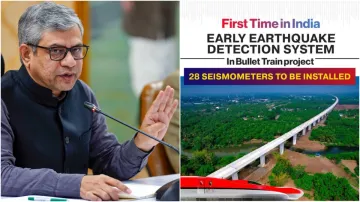In a pioneering move, Union Railways Minister Ashwini Vaishnaw has announced the integration of 28 seismometers into Bharat's Bullet Train, marking a significant leap in ensuring passenger safety. The inclusion of seismometers is aimed at early detection of earthquakes, introducing a proactive measure to mitigate potential risks during high-speed rail journeys.
Strategic placement of seismometers
Out of the total 28 seismometers, 22 will be strategically placed along the alignment of the high-speed rail corridor. Specifically, eight seismometers will find their place in key locations such as Mumbai, Thane, Virar, and Boisar in Maharashtra. Meanwhile, Gujarat will witness the installation of 14 seismometers in cities including Vapi, Bilimora, Surat, Bharuch, Vadodara, Anand, Mahembadad, and Ahmedabad.
The remaining six seismometers, known as inland seismometers, will be deployed in regions prone to earthquakes. These include locations like Khed, Ratnagiri, Latur, and Pangri in Maharashtra, along with Adesar and Old Bhuj in Gujarat, as detailed in the official NHSRCL release.
Advanced detection systems and safety protocols
These state-of-the-art seismometers will be strategically placed in traction sub-stations and switching posts along the alignment. Functioning based on the detection of earthquake-induced tremors through primary waves, these devices will trigger an automatic power shutdown upon identification of seismic activity.
The release further emphasised that the automatic power shutdown will, in turn, activate the emergency brakes on trains operating in the affected area. This dual mechanism aims to swiftly respond to potential seismic threats, ensuring the safety of passengers and the high-speed rail system.
Scientific survey and soil suitability
The decision to install seismometers follows a meticulous survey conducted by Japanese experts along the high-speed corridor. Areas with a history of earthquakes exceeding a magnitude of 5.5 in the past 100 years were identified for the implementation of this advanced safety system.
The selection of specific sites for seismometer installation underwent a detailed survey and soil suitability analysis, incorporating a microtremor test. The culmination of these efforts underscores the commitment of NHSRCL to prioritize passenger safety and embrace technological advancements in the realm of high-speed rail travel.
This groundbreaking initiative marks a pivotal moment for the Mumbai-Ahmedabad 'bullet train' corridor, placing it at the forefront of global standards in safety measures for high-speed rail systems. The integration of Japanese Shinkansen technology, coupled with strategic seismometer placement, positions the NHSRCL as a trailblazer in ensuring the security and well-being of travelers.
Also read | Modi government extends ban on SIMI for five years under UAPA
Latest India News
